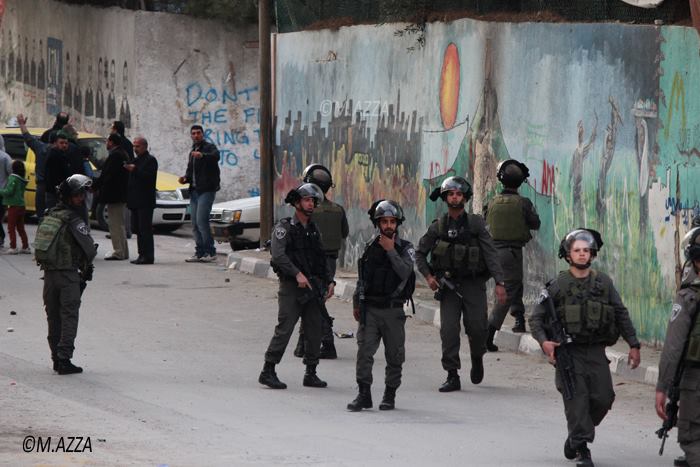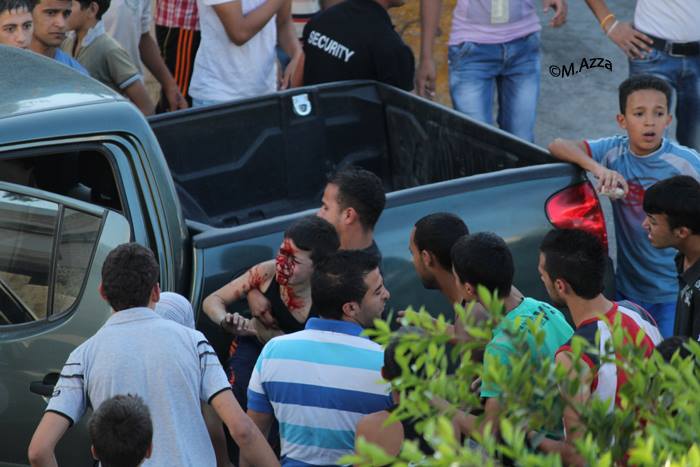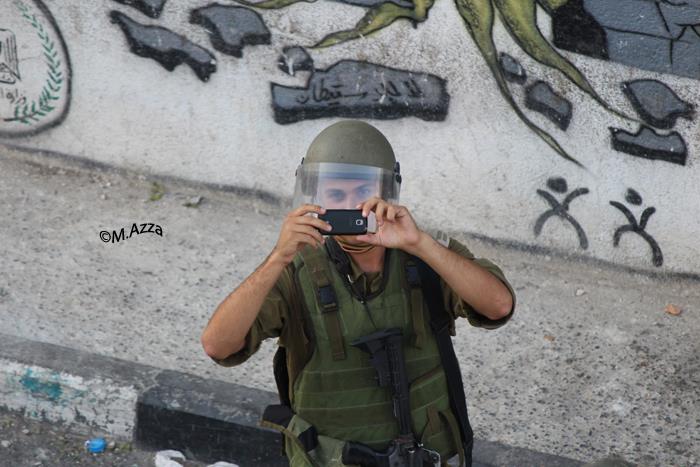Originally published by Ma’an News Agency on February 11, 2014.
Tucked behind the luxurious Intercontinental Hotel in the northern edges of Bethlehem sits the crowded Aida refugee camp.
Reacting to the growing presence of Israeli troops over the past two months, local youths are increasingly confronting soldiers in and around the camp, where more than 3,000 people squeeze into an area of land less than a third of a square mile wide.
On most days since Christmas, the sounds of tear-gas canisters and occasional live bullets echo across the nearby hills, and the clashes occasionally spread beyond the camp onto Manger Street, a central Bethlehem artery which abuts Israel’s wall.
The touristic city of Bethlehem, meanwhile, has remained mostly quiet despite the clashes in its northeastern corner. The youths of Aida face this violence on their own.


12 youths injured in January
In the month of January, twelve youths were injured by rubber-coated steel bullets or live fire, according to local activists.
Although many are hurt during clashes between rock-throwing youths and soldiers, others just find themselves in the wrong place at the wrong time.”Some are just walking by the wall when they get hit, usually in the knees, says Mohammad Alazza of the local grassroots Lajee community center.
“Sometimes the bullets will hit their knees and shatter their kneecaps.”
In one such incident on Jan. 17, a boy named Ahmad was out walking when an Israeli soldier shot him with a rubber-coated steel bullet at close range.”These kinds of bullets should be shot from 75 meters at least, and yet they hit him from 10 meters and shattered his jaw,” Alazza says.
Wared, another teenager who was injured the same day, was visiting his aunt when he “heard the sound of stun grenades going off.”
“I went outside with some friends to see what was happening … As the soldiers started approaching, we started going back,” Wared said.
“The soldiers then began to shoot … and a bullet hit me,” he recounted in an interview at the Arab Society Hospital where he was being treated.
“I didn’t feel it. I started looking at it, and blood was pouring out, but I couldn’t understand what had happened.”


A militarized enclave
At the heart of the conflict in Aida is the Israeli separation wall.Although olive orchards used to extend from the camp’s northern side, providing a natural park in an otherwise congested neighborhood, the wall now snakes around the area and divides it from the open space.
After its construction, which started in 2003 and lasted about five years, the wall added a new level of surveillance and interference in the daily lives of camp residents, even as Israeli incursions in the rest of Bethlehem became less frequent.
It also created a militarized enclave around nearby Rachel’s Tomb, which many Jews and Christians believe to be the site of the biblical matriarch’s grave. Many Muslims also refer to the tomb as the Bilal bin Rabah Mosque.
The tomb is inside Bethlehem but Israel built the wall to surround it, effectively annexing an entire strip of land inside this Palestinian residential area and creating an exclusively Jewish holy site, cut off from local worshipers.


‘The most beautiful moment was when we opened the wall’
The latest round of clashes in Aida can be traced back to November 2012, when Israel launched an aerial assault on Gaza.
The assault provoked angry confrontations with Israeli forces across the West Bank, reinvigorating resistance to the occupation in areas that had been mostly quiet for years.
Soon after the assault began, youths gathered and burned hundreds of tires near a large watchtower that overlooks the center of Aida camp. The fire caused severe damage, and the next morning people proceeded to drill through the wall.
“This was the most beautiful moment, when they opened the wall and we could see the other side,” says Alazza, the Lajee Center official.
Although Israeli soldiers quickly entered the camp to repair the damage, the idea soon caught on like wildfire throughout the West Bank.
“This was the first place where youth began physically destroying the wall, but now it has been done everywhere,” Alazza says with pride.
Since then, however, army assaults on the camp have increased and are often unprovoked, occurring at all hours of the day and night.
One of the most dangerous aspects of these raids, Alazza says, is the reckless shooting of tear-gas canisters from the six watchtowers surrounding the camp, hitting homes and creating a health hazard for residents.
In the course of 30 minutes, they regularly fire 250 canisters, says Lajee Center director Salah Ajarma, who maintains that these responses to rock-throwing youth are wildly disproportionate.
“The tower is built to withstand rockets. How could rocks hurt it?” he asks.One possibility, Ajarma argues, is that the raids are a form of “live training.”
An Israeli army spokesman did not respond to inquiries about the escalating violence or soldiers’ frequent use of live fire against demonstrators.
But military guidelines allow soldiers to conduct live-fire drills in residential areas without warning residents, and the raids often spur clashes.


‘There will be no peace without return’
Many in the camps don’t see an end to the clashes without a larger agreement that ends the Israeli occupation and recognizes the refugees’ right to return.”The clashes are part of the resistance in all the camps,” Ajarma explains.
“There is no solution in the ongoing negotiations, and the new generation sees that rocks and resistance are the most successful way to get the world’s attention,” Alazza adds, referring to US-sponsored talks between Israel and the PLO that have so far borne little fruit.
“The goal is the end of the occupation, and (the protests) won’t end until the occupation ends,” he says. “The soldiers need to know they’re not wanted.”
Muhannad, a 17-year-old from Azza who frequently takes part in the clashes, links his participation to his right to return to the village of Beit Jibreen from which his family and hundreds of others were expelled in 1948.
“I go to clashes because I have the right to return … We want the whole world to know, not just England or the US, but also our leaders in Palestine,” he said. “The right of return is sacred, and Oslo is a failed agreement because it tried to take the right to return from us.”He added: “There will be no peace without return.”Nour, another protester from Azza camp, agrees.
“I support the resistance by throwing rocks. I have the right of return, and I will not forget. I (participate) in order to return to my home,” he told Ma’an.”I will resist until I attain my freedom.”